Table of Contents
Clean aluminum is crucial for successful welding. Contaminants and oxidation hinder the process, affecting the weld quality. In this guide, discover step-by-step methods, essential equipment, and pitfalls to avoid when preparing aluminum for welding. Uncover the advantages of pristine welds and tackle the challenges of aluminum welding. Dive into the importance of meticulous cleaning in ensuring sturdy, lasting welds.
1. How to Clean Aluminum for Welding
Welding aluminum is a process that demands precision and attention to detail, and a crucial aspect of achieving successful aluminum welds is thorough cleaning. The introduction sets the stage for understanding why cleaning is an essential prerequisite for welding aluminum effectively.
The Significance of Clean Aluminum
Aluminum, known for its lightweight and versatile properties, is a popular choice in various industries. However, its susceptibility to oxidation and the presence of contaminants can significantly impact the welding process. A clean aluminum surface is paramount for creating strong, durable welds that meet industry standards.
Purpose of the Guide
This comprehensive guide aims to provide a step-by-step approach to cleaning aluminum for welding. Whether you are a novice or an experienced welder, understanding the nuances of aluminum cleaning is crucial for achieving welds that not only meet but exceed expectations.
The Challenges in Aluminum Welding
Aluminum welding presents unique challenges, such as oxidation sensitivity and high thermal conductivity, which can affect the overall quality of welds. This guide addresses these challenges by offering insights into effective cleaning methods, proper equipment usage, and precautions to ensure a seamless welding process.
What to Expect
Readers can expect to gain a deep understanding of the cleaning procedures required before welding aluminum. From the tools and equipment needed to the potential pitfalls to avoid, this guide will serve as a comprehensive resource for anyone looking to enhance their aluminum welding skills.
2. Step-by-Step Cleaning Procedure
-
Degreasing to Remove Contaminants
Before welding aluminum, removing contaminants is vital. Use a solvent-based cleaner or a mild alkaline solution to degrease the surface thoroughly. Apply the cleaner with a clean cloth or a brush, ensuring all areas are covered. Rinse the aluminum with water to remove the cleaning solution residue. This step eliminates oils, grease, or other foreign substances that could compromise the weld.
-
Eliminating Oxidation Layers
Aluminum readily forms oxide layers, which can impede welding. Remove these layers using methods like wire brushing, sanding, or chemical treatment. Wire brushing or sanding helps mechanically eliminate the oxide layer, exposing a clean surface. Chemical treatments involve acidic solutions that dissolve the oxidation; however, extreme caution is necessary to avoid damaging the metal.
-
Importance of Surface Preparation
After degreasing and oxide removal, surface preparation is key. Use a dedicated aluminum cleaner or a mild acid solution to etch the surface slightly, enhancing adhesion for the weld. This step promotes a clean, receptive surface for successful welding, ensuring a strong bond between the metals.
-
Drying the Aluminum
Once cleaned and prepped, ensure the aluminum is completely dry before welding. Moisture can affect the welding process and compromise the quality of the weld. Use clean, dry towels or allow ample time for natural drying to prevent any moisture-related issues during welding.
By following these step-by-step procedures for cleaning aluminum, you pave the way for successful and durable welds, minimizing the risk of contaminants and ensuring optimal welding conditions.
3. Equipment for Effective Aluminum Cleaning
-
Cleaning Agents and Solvents
Selecting the right cleaning agents is crucial for effective aluminum cleaning. Solvents like acetone, isopropyl alcohol, or specific commercial degreasers work well for removing oils and contaminants. Ensure these solvents are compatible with aluminum and follow safety guidelines when using them.
-
Brushes and Abrasives
Wire brushes, abrasive pads, or sanding materials are essential tools for removing oxidation layers. Stainless steel wire brushes are commonly used to mechanically clean the aluminum surface. Abrasive pads or sandpaper help smooth the surface after oxidation removal, preparing it for the welding process.
-
Aluminum-Specific Cleaners
Dedicated aluminum cleaners or mild acidic solutions aid in surface preparation. These cleaners are formulated specifically for aluminum, ensuring effective oxide removal without causing damage. They help in etching the surface for better weld adhesion while maintaining the integrity of the metal.
-
Protective Gear
When using cleaning agents or abrasives, protective gear is essential. Gloves protect your hands from chemicals or abrasive materials, while goggles shield your eyes from potential splashes or debris. Additionally, ensure proper ventilation when working with chemical cleaners to avoid inhaling fumes.
-
Cleaning Tools and Accessories
Having a set of dedicated cleaning tools for aluminum, such as lint-free cloths, clean brushes, and non-contaminating containers for solvents, ensures the effectiveness of the cleaning process. Keeping these tools separate from those used for other metals prevents cross-contamination.
-
Equipment Maintenance
Regularly maintaining cleaning equipment ensures its efficacy. Clean brushes and abrasives after use to prevent cross-contamination or the transfer of contaminants to freshly cleaned aluminum. Properly storing solvents and cleaners in sealed containers maintains their potency for future use.
Using the right equipment and maintaining it properly ensures thorough and efficient cleaning of aluminum surfaces, setting the stage for successful welding by eliminating contaminants and preparing the metal for optimal bonding during the welding process.
4. Preparing Procedures for Aluminum
Recommended Steps
- Surface Inspection: Begin by assessing the aluminum surface for any visible contaminants, oils, or oxidation layers. Identify areas that require specific attention.
- Degreasing Process: Use a suitable solvent or mild alkaline solution to thoroughly degrease the aluminum surface. Ensure complete coverage and remove any residues.
- Oxide Removal: Employ wire brushing, sanding, or chemical treatments to eliminate oxidation layers. Carefully select the method based on the thickness of the oxide layer and the condition of the aluminum.
- Surface Etching: Apply an aluminum-specific cleaner or mild acid solution to etch the surface slightly. This aids in improving adhesion for the weld by creating a clean, receptive surface.
- Rinsing: Rinse the aluminum well with water after each cleaning procedure to get rid of any cleaning
- Before moving on to the next step, make sure the surface is fully clean.
- Drying: Allow the aluminum to dry completely. Use clean, dry towels or air-drying to ensure there is no residual moisture before welding.
Precautions to Avoid
- Avoid contamination: Prevent cross-contamination by using dedicated cleaning tools and solvents exclusively for aluminum. Keep these separate from tools used for other metals.
- Avoid Corrosive Cleaners: Refrain from using harsh or corrosive cleaners that could damage the aluminum surface. Always opt for cleaners specifically formulated for aluminum.
- Avoid Excessive Abrasion: While removing oxidation layers, avoid excessive abrasion that might compromise the integrity of the aluminum. Use appropriate abrasives and techniques.
- Avoid leaving residues: Ensure thorough rinsing after each cleaning step to prevent any residues that could affect the welding process.
Importance of Proper Prepping
Proper preparation of aluminum is fundamental to achieving high-quality welds. It ensures a clean, oxide-free surface that promotes optimal bonding during welding. Following recommended steps while being mindful of precautions prevents potential issues that could compromise the weld quality and structural integrity of the joint.
5. Understanding the Impact of Clean Welds
Advantages of Pristine Welds
- Enhanced Strength: Clean welds exhibit superior strength as they create a more robust bond between aluminum pieces, ensuring structural integrity.
- Reduced Porosity: Contaminants and oxidation can lead to porosity in welds, causing weaknesses. Clean surfaces minimize this, resulting in stronger and more reliable welds.
- Improved Aesthetics: Clean welds often have a neater appearance, contributing to the overall visual appeal of the finished product.
- Better Conductivity: A clean weld ensures better electrical conductivity, which is crucial in applications where conductivity is essential, such as electrical components.
Disadvantages of Contaminated Welds
- Reduced Strength and Durability: Contaminated welds are prone to weakness, reducing the overall strength and durability of the joint, potentially leading to structural failures.
- Increased Risk of Defects: Contaminants can cause defects like porosity, cracking, or lack of fusion in welds, compromising their quality and functionality.
- Aesthetic Issues: Welds with contaminants may appear messy or irregular, affecting the visual appeal of the final product.
- Functional Impairments: In applications where conductivity or specific properties are crucial, contaminated welds can result in functional impairments.
Impact on Longevity and Performance
Clean welds significantly contribute to the longevity and performance of aluminum structures or products. They ensure the structural integrity needed for long-term durability and reliability. Conversely, contaminated welds compromise these aspects, potentially leading to premature failure or the need for repairs.
6. Challenges in Aluminum Welding
- Oxidation Sensitivity
Aluminum is highly susceptible to oxidation. As the metal is exposed to air, it rapidly forms an oxide layer, hindering the welding process. Managing and removing this layer without causing damage to the metal is a significant challenge in aluminum welding.
2. Thermal Conductivity
Aluminum’s high thermal conductivity makes it challenging to weld compared to other metals. It dissipates heat rapidly, requiring precise control of welding parameters to prevent overheating or inadequate penetration during the welding process.
3. Porosity Issues
Contaminants and oxide layers on aluminum surfaces can lead to porosity in welds. Gases trapped within the weld due to these contaminants create voids, weakening the weld’s structural integrity.
4. Proper Joint Design
Aluminum’s unique properties demand specific joint designs for effective welding. Ensuring proper fit-up and joint configurations is crucial to achieving strong and durable welds in aluminum structures.
5. Material Contamination
Contamination from sources like oils, grease, or even the equipment used for handling aluminum can adversely affect the welding process. Maintaining a clean environment and using dedicated tools for aluminum are essential to avoid contamination issues.
6. Welding Technique Adaptation
Aluminum welding often requires specialized techniques compared to other metals. The use of appropriate welding processes, filler materials, and equipment adjustments is necessary to accommodate aluminum’s characteristics.
7. Importance of Prior Cleaning for Welding
1. Techniques for Optimal Weld Quality
- Enhanced Bonding: Prior cleaning of aluminum surfaces ensures proper bonding during welding, creating stronger and more reliable welds.
- Minimized Contaminants: Cleaning eliminates contaminants that can cause defects like porosity or lack of fusion, ensuring a defect-free weld.
- Reduced Oxidation Effects: Cleaning removes oxide layers, minimizing their impact on the welding process and promoting better fusion between metals.
2. Longevity and Durability of Welds
- Extended Lifespan: Clean welds contribute to the longevity of aluminum structures, reducing the likelihood of premature failures or repairs.
- Improved Performance: Welds free from contaminants and oxidation maintain their structural integrity, ensuring optimal performance in various applications.
3. Safety Considerations
- Avoiding Hazards: Cleaning aluminum before welding reduces the risk of hazards caused by contaminants, ensuring a safer working environment.
- Avoiding Health Risks: Eliminating exposure to harmful chemicals or fumes from contaminants enhances the safety of welding operations.
4. Cost-Efficiency
- Reduced Rework: Clean welds minimize the need for rework or repairs, saving time and resources in the long run.
- Enhanced Productivity: Efficient cleaning procedures streamline the welding process, improving overall productivity and reducing downtime.
5. Environmental Impact
- Reduced Waste: Effective cleaning reduces the generation of scrap due to faulty welds, promoting a more sustainable approach to manufacturing processes.
- Healthier Work Environment: Proper cleaning practices contribute to a cleaner and safer work environment for welding operations.
Conclusion
As we delve into the intricacies of cleaning aluminum for welding, it becomes evident that this initial step plays a pivotal role in the success of the entire welding process. By grasping the importance of cleanliness and following the detailed steps provided in this guide, welders can elevate their craftsmanship, resulting in stronger, more durable aluminum welds.
FAQs
Why is cleaning aluminum essential before welding?
Cleaning removes contaminants and oxide layers, ensuring a strong, defect-free weld.
What cleaning agents work best for aluminum?
Solvents like acetone or mild alkaline solutions are effective for degreasing, while aluminum-specific cleaners aid in oxide removal.
Can I use regular steel brushes for aluminum cleaning?
It’s recommended to use stainless steel brushes specifically designed for aluminum to prevent contamination.
How crucial is drying the aluminum after cleaning?
Completely drying the aluminum is vital to prevent moisture-related issues during welding.
Can I weld aluminum without cleaning it first?
It’s highly discouraged as cleaning significantly improves the quality and integrity of aluminum welds.
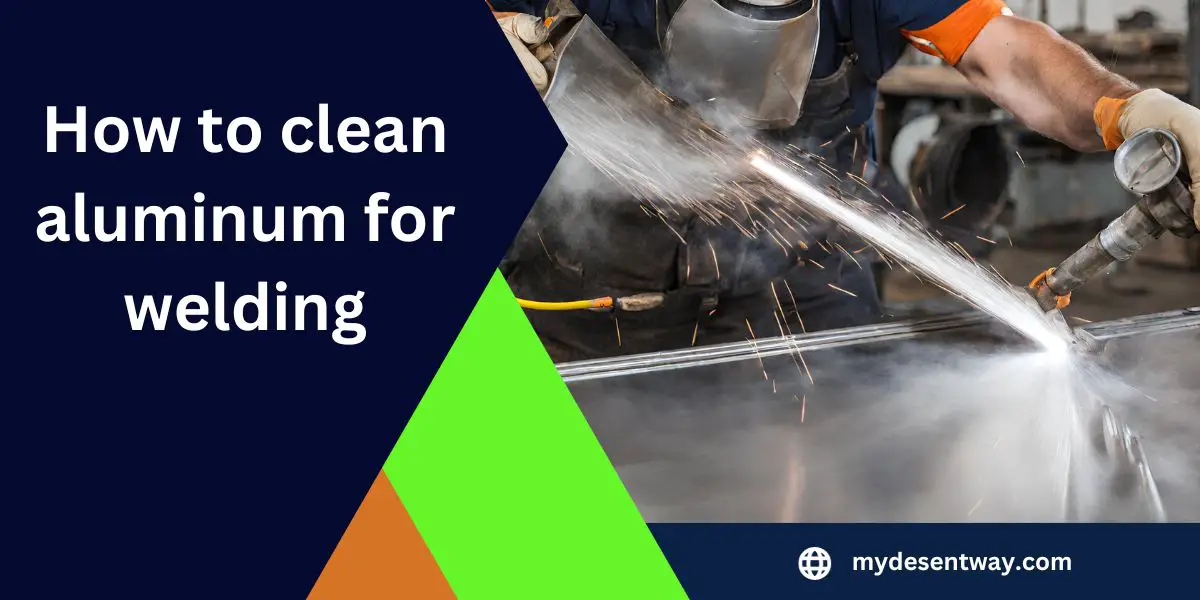
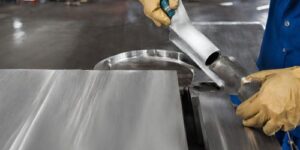
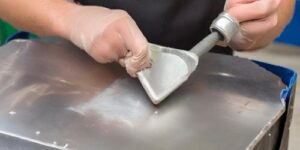
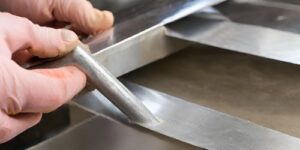

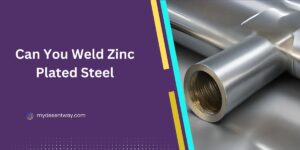

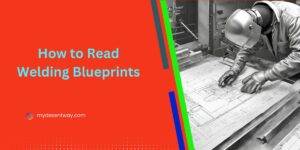




6 thoughts on “How to Clean Aluminum for Welding: Expert Guide”